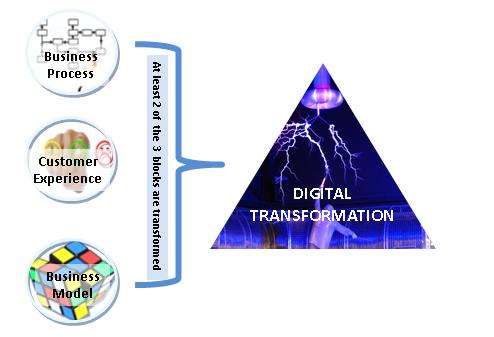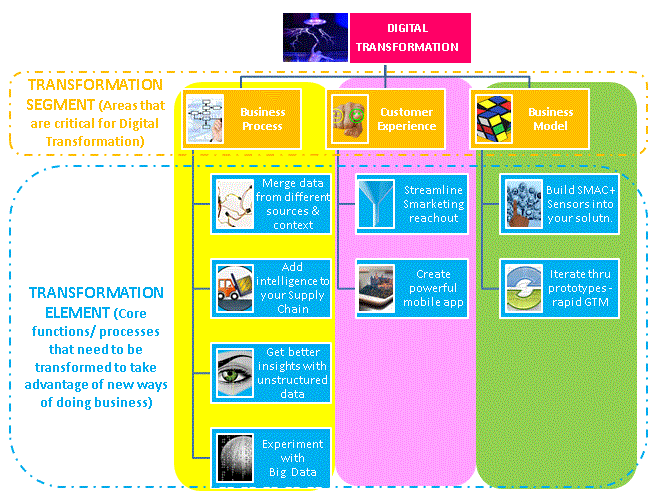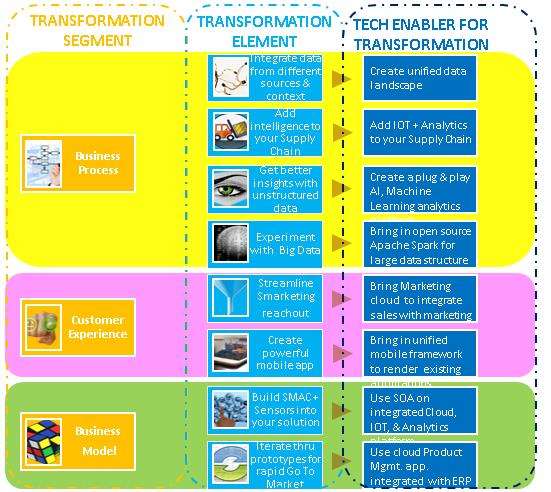Digital Transformation using SAP
Popularity of the term ‘digital transformation’ can be gauged by the fact that a Google search of the term will give you 5.81 million results. At its widest meaning ‘digital transformation’ can apply to an individual, a society, an organisation, or an industry or group of companies. In this article, we will focus only on the transformation happening in business. We will focus on companies who are using SAP or considering using SAP as an underpinning of the transformation – doing “Digital Transformation using SAP”.
What is Digital Transformation?
There are lots of companies, industry bodies, thought leaders defining what digital transformation is and what it is not
Diageo’s CEO Ivan Menezes while explaining the context of Digital marketing mentioned that “It’s not about doing ‘digital marketing’; it’s about marketing effectively in a digital world.” The same can be applied to ‘digital transformation’. It’s about transforming a business in a digital world and not about ‘digital transformation’.
Removing the hype in Digital Transformation
Like in all trending topics, there is a huge amount of hype around Digital Transformation and we need to understand what is included in Digital Transformation and what is excluded.
A big part of Digital Transformation is in using technology but it is NOT just about technology sector or tech start-ups. While Uber and Airbnb are talked about as examples of digital transformation at a business model level, they are more of a digital-only business model and absolutely not the only end product of digital transformation. Digital transformation also happens when a traditional smoke-stack industry improves its competitive position by attuing itself to the digital environment.
Examples of initiatives in isolation which are NOT digital transformation:
- creating a fully responsive mobile website
- developing a social media strategy
- getting into social media services as a business
- implementing ERP like SAP
- moving from an op-premise version of ERP to cloud version
Just digitizing business processes – from spreadsheets to ERP is over 40 years old. That is not digital transformation.
A caveat for our discussion on Digital Transformation – technology is necessary but not sufficient
Just to keep ourselves true to our tech spirit, we are talking about Digital Transformation in businesses enabled by technology. We not going to overtly focus on large scale people re-skilling or offering new skills. Our digital transformation is going to be driven primarily by technology. We are not saying that this is necessarily a complete view of digital transformation. But for the sake of this article our focus is on the tech enabled digital transformation only.
Using technology alone is necessary but not sufficient to ‘digitally transform’ in the holistic sense. But integrated enterprise software and the associated technology and frameworks are together a critical first step & glue that gives you the freedom to imagine more, do more.
What are the building blocks of tech enabled Digital Transformation?
Digital transformation entails making the best of the digital landscape, capabilities, & market opportunities. These are the constituents of digital transformation:
- Business Process transformation
- Customer Experience transformation
- Business Model transformation
For true digital transformation to happen, atleast two if not three of the Business Process /Customer experience / Business Model need to significantly change.
Changing business processes generally tend to be the easiest. Changing Customer experience tends to be more difficult. And changing a company’s business model or the entire ecosystem the player operates in tends to be the most difficult.

FIGURE 1: Digital Transformation Building Blocks – Business Process Customer Experience and Business Model
Why Digital Transformation using SAP?
- SAP’s core ERP product on the HANA cloud – SAP S/4HANA – runs real-time and integrates predictive analytics, Big Data, & mobile has the ideology, features, and connections necessary to be at the core of the digital enterprise.
- SAP is not a huge complex ERP enterprise application. Its simplified services offerings makes it easier to use SAP, consume service-type offerings with customisations and co-engineer with customers as well as partners like us – Peol Technologies – to simplify running SAP.
- SAP’s model company & model industry solution approach has made it easy to get digital innovation at huge speeds, enabling usage of digital reference architecture with agile servicing.
We will now look at how we can do Digital Transformation using SAP by following a simple 3 step approach:
STEP 1: Digital Transformation using SAP by connecting transformation areas with core functions / processes
First Step: Visualise your long term business goals, and the business model and business processes required for you to reach there & create a roadmap taking you there.
You can start with defining the important key segments – the key areas, ‘big rocks’ that are important for you to transform.
Break the areas – segments into key elements – functions & processes that have a disproportionate impact on your business and must be changed to take advantage of the technology overhang.
Understand what problems of your customers you are trying to solve. Create your business model and supporting business processes <to-be> to reach there. Use business planning, design thinking workshops, & other tools to reach there.

FIGURE 2 Digital Transformation Elements – Core functions & processes that need to be transformed to take advantage of new ways of doing business
We did a standard analysis of typical business processes that need to be reengineered. We found that merging data from different sources & context; adding intelligence to Supply Chain; using unstructured data at another level; experimenting with Big Data, streamlining smarketing reach outs, creating powerful mobile apps, building SMAC & sensors into your solution; rapid Go TO Market by iterating through prototypes were something that were vital for a particular customer scenario.
STEP 2: Digital Transformation using SAP by connecting functions / processes to be re-engineered with tech enablers
After thinking through the business elements that need to be re engineered – map the technology environments and tools – the enablers – we need to apply & rework to support the change:
- You have to visualize tools & environment to turn drawing on napkin to prototype to functioning ecosystem. Prototyping, creating, integrating & extending applications is at the core of the transformation journey
- If self-developed business applications are at the core of your business processes, now is the time to step back a bit and think of the future. Over time companies create different application for business functionality and they are hold together with digital duct tapes and end up looking like a spaghetti horror-show. An Enterprise Services Architecture connecting all the applications on premise /public or private cloud together becomes essential to manage & make best of the legacy application functionality.
- We are creating data all the time. To make better decisions in an era of dwindling storage it costs, it makes sense to store & process the transactional & critical data. We will need a storage platform with clear federation rules and having the features of in-memory, column storage, & parallel processing. This will allow us to harvest the full value of analytics – with all kinds of data we collect – be predictive analytics, geo-spatial analysis , NLP text analytics, and the power to visualize them in the relevant context.

Figure 3 Tech Enabler of functions & processes for Digital Transformation
STEP 3: Digital Transformation using SAP by connecting functions / processes with SAP Solutions
Map technology tools with what SAP has to offer to take you there. If you are already on SAP, the decision becomes easier for you.
SAP has a fast pace of coming out with frameworks & solutions mapped to all elements of the digital ecosystem. Right from data integration using SAP HANA, to SAP Connected Goods for IOT, to SAP Leonardo for Artificial Intelligence + Machine Learning + Analytics platform, to SAP HANA Vora for Big Data Analytics, to Sales & Marketing cloud using SAP Hybris, to Fiori framework for mobile development, to SAP S/4HANA for integrating SAP & non SAP Enterprise applications on an in-memory cloud – the customer gets an integrated yet plug-and-play capable tech platform + stack.

Figure 4: Digital Transformation Using SAP – How SAP helps transform the tech enablers of functions or processes for Digital Transformation
Now you are truly on your Digital Transformation using SAP journey. We from PEOL are always happy to share our best practices in this journey… Bon voyage & don’t hesitate to reach out if you have any questions / thoughts!
All brand names are owned by their respective owners. This article is not endorsed by SAP nor does it constitute any official communication of SAP.
You can read more about our Digital Transformation offerings here
References:
SAP.com web-page on Digital Business and Transformation
SAP Digital Transformation Explained – Youtube whiteboard video





